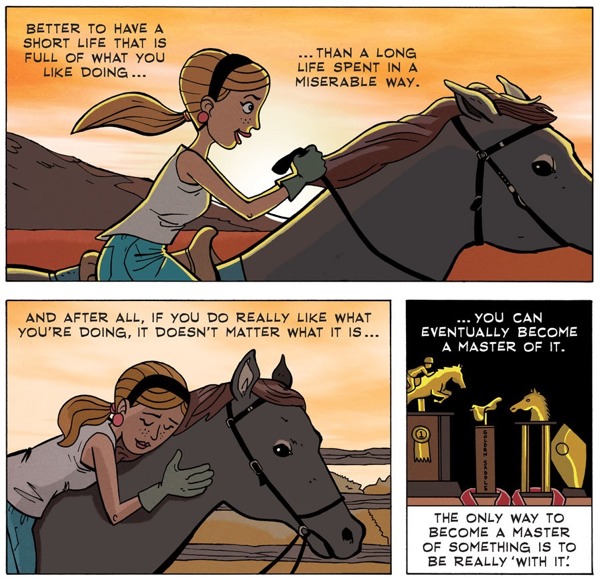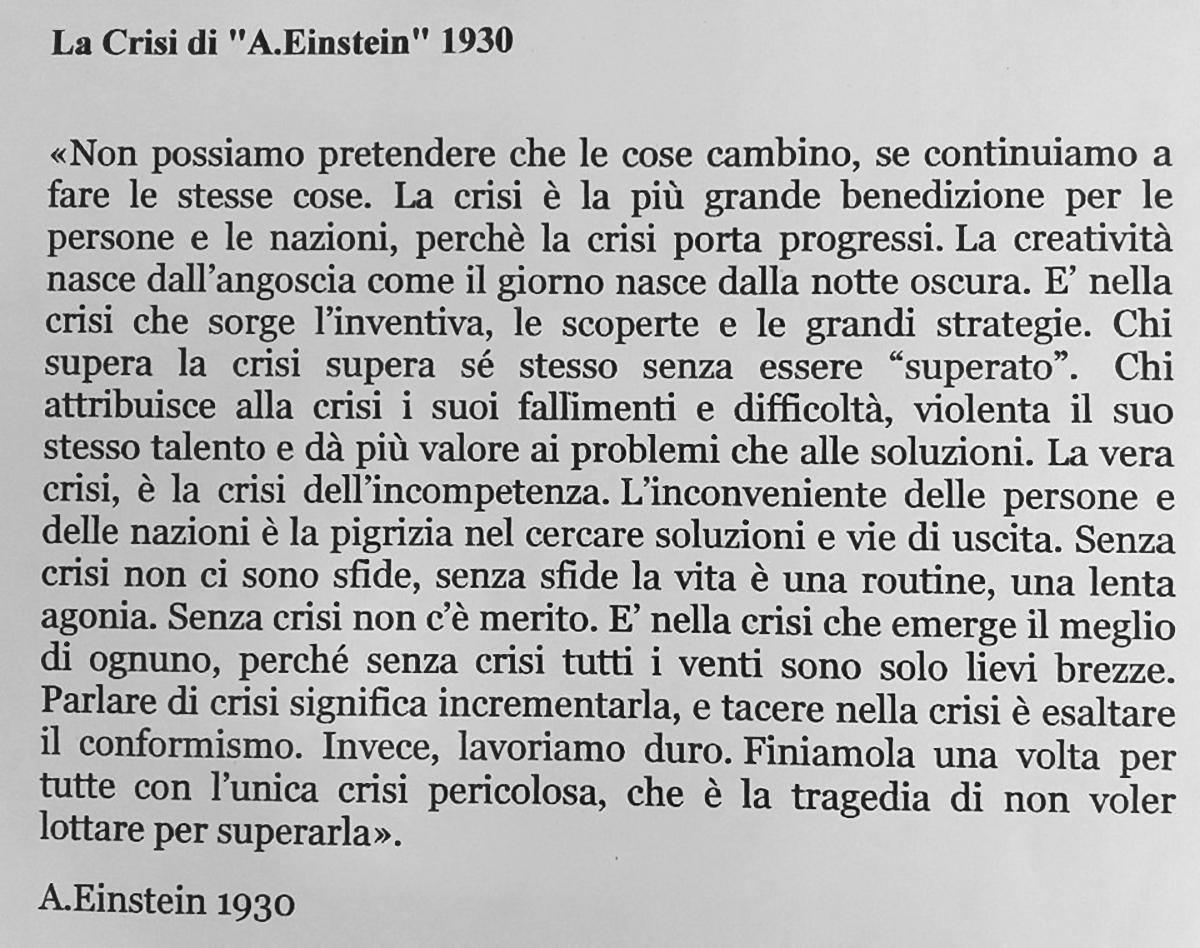Inspirational
» L’obiettivo finale è quello di raccontare una storia ∞
Dalla mia intervista per Mario Palomba su Fuori Corso:
Prima di tutto un invito: non perdete tempo a mettere in piedi un gruppo super-professionale con sito web, video blog su YouTube o chissà cos’altro. Fatevi venire in mente molte idee, e scartatene moltissime. Le buone idee si rivelano a noi perché rimbalzano nella nostra testa anche quando abbiamo altro a cui pensare, cioè quasi sempre. Le riconosciamo perché ci inseguono, ci perseguitano a volte. Le idee sono tutto, fare video perché è una cosa “cool” e lo fanno anche gli altri non serve a nulla. Non fatelo per le visualizzazioni, per i soldi, per i “Mi piace”. Fatelo perché vi piace farlo, sapete farlo (o almeno state imparando) e avete qualcosa da dire. Non scordatevi mai che l’obiettivo finale di un video deve essere quello di raccontare una storia, grande o piccola che sia. Pensate a quello che volete raccontare, e come volete raccontarlo, in ogni fase del lavoro. Tutto il resto è secondario.
La differenza tra dilettanti e professionisti (superare la fase “Oh merda”)
Lo sceneggiatore Craig Mazin, in Scriptnotes (il mio podcast preferito), sulla fase “Oh merda” e quindi sulla differenza tra dilettanti e professionisti:
If you’re doing your job right, at some point you will realize, “Oh shit.” In fact, it happens so regularly that at some point you stop saying, “Oh shit,” and you go, “Oh, well here we are at the ‘oh shit’ moment. Okay. Let me have a drink. I’m going to take a walk. And now let’s recover from it.”
[...]
The difference, I think, between the professional and the amateur is that the amateur panics and either digs in and doubles down or quits.
Come funziona la creatività?
L’ultimo video dell’ottima serie PBS Off Book riguarda la creatività. Denso di riflessioni interessanti sull’argomento (e anche qualche cliché, ma va bene così), vi consiglio di prendere qualche minuto per guardarlo:
Il video mi ha fatto tornare in mente queste parole di John Cleese:
Creativity is not a talent. It is not a talent, it is a way of operating. MacKinnon showed that the most creative had simply acquired a facility for getting themselves into a particular mood
“a way of operating”which allowed their natural creativity to function. In fact, MacKinnon described this particular facility as an ability to play.
» Scegli il lavoro che non puoi non fare ∞
Condivido il concetto chiave del TED Talk How To Find And Do Work You Love di Scott Dinsmore:
The only question that matters is: what is the work you can’t not do? Discover that, live it.
Le idee migliori restano
Evernote. Day One. File di testo (solo testo) su DropBox. App meravigliose. Bellissimi taccuini Moleskine. iPad. Quanti modi diversi abbiamo, oggi, per appuntare le idee che ci vengono in mente? Forse troppi.
È vero che le idee sono fragili – coltivarle è un’arte – ma conservarle tutte può in fin dei conti essere controproducente. Si ritrovano ammassate tutte assieme e quelle migliori rischiano di restare soffocate. La nostra mente, invece, opera istintivamente una selezione e le cose migliori, se tutto va bene, perdurano.
Stephen King, ad esempio, non utilizza taccuini. Con semplici ma efficaci parole dice:
The good stuff stays.
» ‘A short life that is full of what you like doing…’ ∞

L’immagine completa è su Zen Pencils, potete guardarla ascoltando l’audio originale con la voce di Alan Watts.
» Non fare “il coniglio” ∞
Scott Belsky in Why We Should Declare War On Friction:
In most marathons, there are always a few runners that jump to the front of the race at the start and quickly tire. These folks are known as the “rabbits,” and nobody ever takes them seriously even though they appear to be winning the race for a short period of time. The rabbit runs fast but quickly tires.
A truly great marathon runner or cyclist understands the benefits of pacing over the course of a race. Rather than lead, they carefully manage their energy, and even use the other runners in front of them to block the wind and sustain themselves during the race. This practice is called “drafting,” and it involves running a few feet behind a runner to minimize the wind resistance and pace the race.
C’è molto da imparare da questi due brevi paragrafi. Nella vita spesso vogliamo essere primi a tutti i costi, e per farlo ci stanchiamo più degli altri e alla fine perdiamo anche l’entusiasmo. A volte (ma non sempre) è necessario seguire prima di superare.
» Fai una cosa e falla bene ∞
Viviamo in un mondo in cui tutti – facciamo finta per un momento che non esista il digital divide – hanno accesso ‘a tutto’. Questo significa anche che le cose si imparano più velocemente, e quello che si impara diventa obsoleto più velocemente. Insomma è più facile diventare esperti in qualcosa, ma forse è anche più inutile.
Hunter Walk scrive in Welcome to 2013, Where It’s Never Been Easier to be Average:
Is it possible that it’s never been easier to be, well, average? If everyone is learning the same information and studying the same approach, yes the floor rises – we’re all more educated – but what about the ceiling? Who will push outside of the boundaries?
Questi quesiti sembrano non avere risposta, ma l’autore suggerisce:
But continue to challenge yourself. Don’t just become an expert, try to do it differently. Color a bit outside the lines. And you might just find yourself creating the best practices copied by the next wave of learners.
Condivido il suo punto di vista, ma aggiungo un pensiero maturato nella mia esperienza personale: prima di dedicarti ad apprendere qualcosa – l’HTML, il filmmaking, il pianoforte, la pittura – poniti la domanda: è questa la mia vocazione? Oppure, semplicemente, è questa la cosa che voglio fare davvero? Perché, oggi più che mai, devi fare una cosa e farla bene.1
-
Non vi ho convinti? Guardate Inventing on Principle di Bret Victor e How great leaders inspire action di Simon Sinek. Magari volete fare 1000 cose, ma dietro ci dev’essere un pensiero coerente e solido, una motivazione forte.↩
» Il messaggio di Rita Levi Montalcini ∞
Rita Levi Montalcini, scomparsa oggi all’età di 103 anni:
Il messaggio che invio, e credo anche più importante di quello scientifico, è di affrontare la vita con totale disinteresse alla propria persona, e con la massima attenzione verso il mondo che ci circonda, sia quello inanimato che quello dei viventi.
Via Emanuele Menietti, condiviso da Diego Petrucci
» ‘Uninterrupted thought’ ∞
Shawn Blanc in Inbox Intentions:
For a maker, uninterrupted work time is valuable because it allows us uninterrupted thought. [...] But when we interrupt our own time with habitual checking of email, Facebook, Twitter, et al. then it’s like having micro meetings all day long.
Scrive infine:
Because it comes down to our own choices. Are we going to spend our time the way we want to or not? Are we going to do the work we say we want to do or not? Intentions are dandy, but real men get to work.
Grazie Shawn, qualcuno deve pur scriverle certe cose.
» Good Fucking Design Advice ∞
«Because sometimes, being your own worst critic is not enough.»
Questa foto l’ho scattata ieri; il wallpaper lo trovate tra quelli di Good Fucking Design Advice (l’ho anche adattato ad iPhone 5). Date un’occhiata ai loro prodotti, sono fantastici.
Segnalato su Twitter da Gordon Irving
» ‘One thing that all the successful companies in the world have in common’ ∞
Ernest Sirolli in un TED Talk:
The smallest company, the biggest company, has to be capable of doing three things beautifully: the product that you want to sell has to be fantastic; you have to have fantastic marketing; and you have to have tremendous financial management. Guess what? We have never met a single human being in the world who can make it, sell it and look after the money. It doesn’t exist. This person has never been born. We’ve done the research, and we have looked at the 100 iconic companies of the world
Carnegie, Westinghouse, Edison, Ford, all the new companies, Google, Yahoo. There’s only one thing that all the successful companies in the world have in common, only one: none were started by one person.
» Less is not more ∞
To simplify, do not eliminate for elimination’s sake. [...] Less, for the sake of less, is not more.
Simplicity lies on the other side of complexity.
Simplicity is arriving at a conclusion that in retrospect, appears inevitable.
Prima di citare un’altra frase del post, ricordo che qualcuno disse:
Perfection is achieved, not when there is nothing more to add, but there is nothing left to take away.
Ecco, Pedraza vede la cosa in questo modo:
Perfection is attaining the sort of completeness that would not benefit from either subtraction or addition.
Ragionevole.
» Doing more is easier than doing less ∞
Il designer inglese Mark Boulton ricorda la lezione fondamentale che l’insegnante di arte del liceo gli ha impartito:
Doing more is easier than doing less. [...] When someone hires me for my work, they’re not paying me for what I give them. They’re paying for what I don’t give them: the iteration, the obvious ideas, the sub-optimal solutions, the years of experience, the learning I do.
via Shawn Blanc
∞I film e le serie tv [...] costituiscono una traccia sempre più importante: un ricco repertorio di strutture narrative, ruoli e modelli con cui confrontarci e a cui ispirare la nostra lettura delle cose; e anche una grammatica, un insieme di regole, figure e valori da utilizzare nella vita quotidiana.
Sincerità radicale
A life of radical honesty is filled with a hundred confrontations every day. Small, but they’re relentless.
Ogni singolo giorno della nostra vita diciamo ad amici, parenti e colleghi tante piccole, innocenti bugie. Lo facciamo tutti, e la cosa non ci infastidisce particolarmente. Il giornalista A.J. Jacobs ha fatto un esperimento: ha provato ad essere totalmente (o meglio, radicalmente) sincero per un certo periodo di tempo. Per farlo si è rivolto all’esperto di sincerità Brad Blanton, che ha dato vita al movimento Radical Honesty. Questo è quello che ne è venuto fuori, ovvero una riflessione su quello che può produrre la sincerità incondizionata, e su come le piccole menzogne articolano la nostra vita… Continua la lettura.
» Perché non hai ancora più successo? ∞
Perché persone e organizzazioni di successo non hanno automaticamente ancora più successo? Una spiegazione importante è quella che chiamo “il paradosso della chiarezza”, che può essere sintetizzato in quattro fasi:
Fase 1: Quando abbiamo chiarezza d’intenti, questa ci porta al successo.
Fase 2: Quando abbiamo successo, le opzioni e le opportunità si moltiplicano.
Fase 3: Quando abbiamo più opzioni e più opportunità, i nostri sforzi di distribuiscono.
Fase 4: L’impegno così ridistribuito danneggia proprio quella chiarezza che ci ha portati al successo iniziale.Curiosamente, ed esagero proprio per rendere l’idea, il successo porta al fallimento.
Queste sono parole da tenere a mente. E già che ci sono, vi invito ad ascoltare con grande attenzione questo discorso di Bret Victor dall’emblematico titolo “Inventing on Principle”, che ho già segnalato più volte.
(via Kottke)
La spirale crescente delle aspettative
Barry Schwartz in un TED Talk parla della spirale crescente delle aspettative:
Io porto quasi sempre jeans. Una volta i jeans erano di un solo tipo, li compravi e vestivano malissimo, erano scomodissimi, solo dopo averli portati una vita e lavati un sacco di volte, cominciavano ad andare bene. Allora, andai a comprarne un paio nuovo quando quelli vecchi erano andati, e dissi: “Mi serve un paio di jeans, questa è la mia taglia.” Il commesso mi disse: “Li vuole slim fit, easy fit, relaxed fit?” “Li vuole con la cerniera o con i bottoni?

